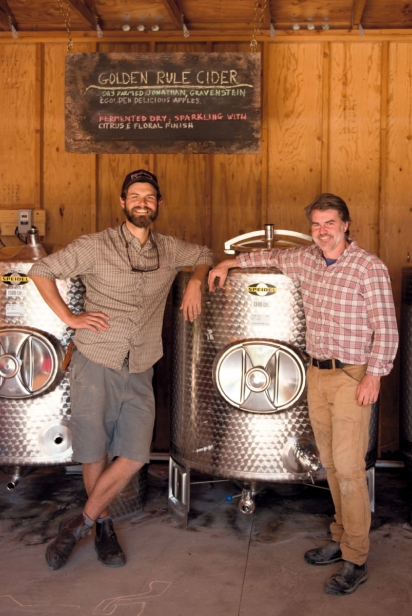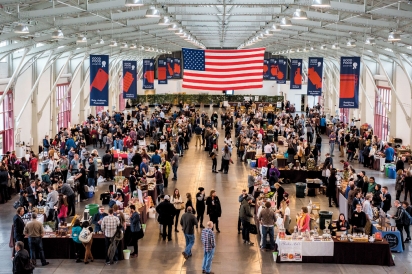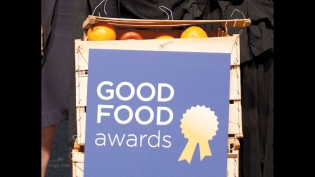Nationwide Awards with Bay Area Roots
Ned Lawton and Ryan Johnston were blending cider in Ethic Cider’s barn when they received an email letting them know that they had won a Good Food Award. It was the cidery’s first year of commercial production after Lawton and his wife left the city for Sonoma County, having bought land that included an apple orchard and found themselves moved by the spirit of Sebastopol’s storied apple heritage to make cider. As with the beginnings of many small businesses, it was a year of figuring things out and wondering where they were headed.
Ethic’s ciders are made from organic dry-farmed apples grown on the Lawtons’ land, as well as other local orchards. The Lawtons have instituted one of the U.S.’s first orchard carbon farming plans on their land, committing to practices that help to remove carbon from the atmosphere. That’s a lot of work on top of growing the business—but after that email they knew they were on the right track.
“There was a lot of high fiving,” said Johnston, who joined the company early on as the orchardist and cider maker.
Ethic Ciders is one of hundreds of crafters across the U.S. whose products have earned the right to fly the Good Food Award (GFA) winner colors, signaling to consumers that their product is not just delicious, but also made with exceptional environmental and ethical standards. While there are plenty of industry awards and competitions that measure taste, the GFA stands out for expanding the definition of “good food” to include these other factors.
There is clearly consumer demand for this type of vetting. From preserves to charcuterie, chocolate, spirits, hot sauces, olive oils, fish, cheese … over 2,000 crafters hailing from every state in the nation submitted their wares to the GFA organization for blind judging by industry leaders and food media this past fall. In January, the winners in each category will be celebrated at a gala emceed by Alice Waters and other food world luminaries.
As the number of submissions has grown since the first Good Food Awards were issued in 2011, along with the GFA’s efforts and ability to promote the work of these artisan producers, so has the organization’s impact on food producers and the retailers who support them. The awards ceremony weekend now includes a market open to the public and an industry-only mercantile connecting crafters with retailers (which repeats later in the year in New York and another rotating city). The mercantile showcases the Good Food Guild, an evolving network of crafters that reaches even beyond the categories in which awards are given. Additionally, the Good Food Merchants Alliance brings together a growing group of independent retailers that collaborate year-round.
“There are a tremendous amount of judging and contests for cider and wines, but the philosophy of the Good Food Awards aligns with our philosophy of how to grow and make our apples and cider,” said Ethic Cider’s Lawton.
It’s also one of the few recognition-based competitions that is cross-industry, holding each category to unique standards but grouping together a diverse range of businesses who connect over likeminded values.
For Sarah Weiner, the co-founder of the GFA’s parent organization, the Good Food Foundation (GFF, initially named Seedling Projects), the aha! moment that set her on a course to change how America produces and consumes food, came while working on the Slow Food Nation gathering that happened in San Francisco in the summer of 2008. “Slow Food Nation brought together producers from all around the country, but they didn’t have the ability to continue the conversation outside of their industry silos,” said Katherine Harris, GFF’s Merchants and Communications manager. The GFA was specifically created to encompass both taste and sustainability, and bridge different industries. It would also directly engage retailers and consumers.
Today, there are 16 award categories with a plan to add a new one each year. (Say goodbye to post-munchies guilt: In 2019 it’s snacks!) Judges are picked from around the country, a mix of chefs, food writers and artisans who come together in San Francisco to participate in blind tastings and score based on flavor. The judges’ favorites are then vetted by the GFA team for their practices—including the sustainability of their sources.
Criteria have developed over time and are reevaluated every two years to be progressive, but realistic. Standards are specific to each category, but always require that entries be free of genetically modified and artificial ingredients, have transparent and traceable supply chains, and support sustainable agriculture.
“We want to push everyone forward, but also make sure that the measurements feel appropriate,” said Harris. They get feedback from producers, who provide updates on issues that are affecting their industries and how businesses are responding.
“The process is rigorous,” said Cindy Daniel, owner of the James Beard Award–winning cafe, market and community gathering space Healdsburg SHED. SHED swept the awards last year with its house-smoked trout and black cod, pickled shiitake mushrooms and plumshiso shrub. In 2019, they are finalists for their Trout Rillette, Smoked Sturgeon, Sweet and Salty Granola and Raspberry Rose Preserves.
SHED is in the unique position of being both a crafter itself, as well as a buyer that shops the Good Food Mercantile to stock its expertly curated marketplace, as well being a part of the Good Food Merchants Collaborative, the organization that helps underwrite the GFA. As a retailer, Daniel says her life is made easier by the GFF’s work—not just in finding products for the SHED market, but in collecting the producers’ stories to transmit to their customers.
“That sort of rigor has been something that, once we started making our own products, really helped us and informed us,” Daniel said, adding that a couple of times they made adjustments to their recipes to comply with GFA standards (they had to hunt down organic white soy sauce for their mushroom brine, for example).
For those participating crafters who don’t take home awards, the Good Food Mercantile is nonetheless an opportunity to get their products in front of retailers who are looking for small-batch or “more sustainably” produced products. All Good Food Guild members are able to participate, qualifying by having 51% of their product line meet award standards for each category. The trade-only event attracts about 800 retailers and media organizations each year. Daniel, who says she prefers buying at the Mercantile to larger, mainstream trade shows, called it an “edited experience.”
“The great thing about the Mercantile is that the buyers it attracts are the type of buyers that have similar values; they are looking for high-quality products with real ingredients, and they are not just looking for the cheapest products,” said Katie Henshaw, sales manager of Clif Family Winery, Kitchen and Clif’s Bruschetteria food truck. The Napa Valley farm and winery owned by Gary Erickson and Kit Crawford, co-founders of Clif Bar, produces a number of packaged foods, this year debuting a chocolate line co-conceived by their winemaker and chef. The Mercantile has become a must-attend event for Clif, enabling them to connect with both current customers and new ones.
With an activated audience of leaders in the good food retailer space, the awards and Mercantiles are creating a reliable economic channel for small crafters. A majority of the 2016 Good Food Award winners saw an immediate spike in sales; 54% of winners said that their orders increased upon the announcement of their finalist status, and half noticed an instant increase after the announcement of the GFA winners.
“We probably got 15 to 20 new retail accounts that we didn’t know who came to us or who we got automatic credibility with because of the award,” said Lawton. “It opened up a lot of doors.”
Resources like that are key for businesses that often exist on the margins.
“We see chocolate makers who are voted the best in the country, and basically tell me they couldn’t do this if they weren’t living on their wife’s income,” said GFA’s Weiner.
The struggle is even more real for entrepreneurs who don’t have the necessary social capital or access to start-up funds, creating a glaring lack of diversity among successful craft food business owners. Weiner says by keeping entry costs low and subsidizing some costs, plus increasing the number of specific categories (sambal, miso, salsa, etc.), she hopes the awards will become more inclusionary.
Despite the challenges for small producers, almost a decade after launching the awards the U.S. food system and good food’s role in it has shifted tremendously. Big food—a term used for industrialized agriculture and major packaged food producers—is feeling the changing tide as consumers demand more authenticity and simpler ingredient lists. In her remarks at the last GFA gala, Weiner reminded the crowd that the 20 largest food corporations in America have lost $18 billion of market share since the GFA first launched. As some companies ride the wave by acquiring small craft or health food businesses, they are also succumbing to the market demands: replacing synthetic ingredients, removing GMOs, cutting sugar.
“The big guys are scrambling because the small guys are changing what people want to eat in America,” said Weiner. “It can seem small, what any food crafter is doing, but I’ve seen time and again that the impact of what they’re doing is shifting the demands that consumers have and it’s impacting the food industry at the biggest possible levels.”
The shift presents the GFF and its network of crafters with an interesting challenge and opportunity. While Americans might be reaching more for small-batch granola, many still balk at the price tag. Not only is the price of artisan-crafted food out of reach for many Americans, but a food system built on cheap labor and industrialized production has skewed everyone’s perception of the real cost of food.
“We know that there’s a huge hunger for the work that we do— people are into amazing cheese and fantastic coffee—there’s a demand,” said Weiner. But, she said, people’s expectations of how much things cost isn’t aligned with what it actually costs to make those products (expenses like living-wage labor and organic ingredients easily add up).
By her calculation, convincing the upper-income swath of Americans to change their shopping habits can change the whole of the food industry. With more support for good food comes good jobs, and more pressure on the entire industry to adapt, she argues.
To do that, the GFF is zeroing in on supporting a vital pillar for good food: retailers. The Merchants Alliance creates structured, as well as informal, opportunities for business owners in a quickly changing landscape to share specific resources. SHED’s Daniel for instance, said she reached out to Danielle Vogel, founder of Glen’s Garden Market in Washington, DC, for help with staff training. Next year, the Merchants Alliance is hoping to host a summit for retailers to share best practices.
It’s this sense of community and recognition that participants at all levels say creates an impact beyond sales stats. For Lawton, networking with others in his industry and beyond has helped tackle barriers in production, marketing and other business growing pains. Clif ‘s Henshaw said the community vibes are just as important as the retail opportunities, and uses the Mercantile as a vehicle to get feedback, try out new ideas and trade sourcing or equipment tips. There are also other opportunities to collaborate, such as events like the cider pairing dinner co-hosted by SHED and Ethic in November.
While Weiner is tracking the big picture, the GFF events also provide her with a reminder of why recognition is so important for these food businesses. Sometimes, it’s the motivation they need to keep going.
She remembers the moment after the first GFA gala when her nervous anticipation was met with a feeling of satisfaction. The event had gone smoothly, and she was walking down the stairs to enjoy the party. “I got stopped by one woman who was in tears, she said that her daughter-in-law is in her basement making sauerkraut all day, every day, and was never recognized until today,” she recalled. “That’s when I realized this really meant something to people.”










